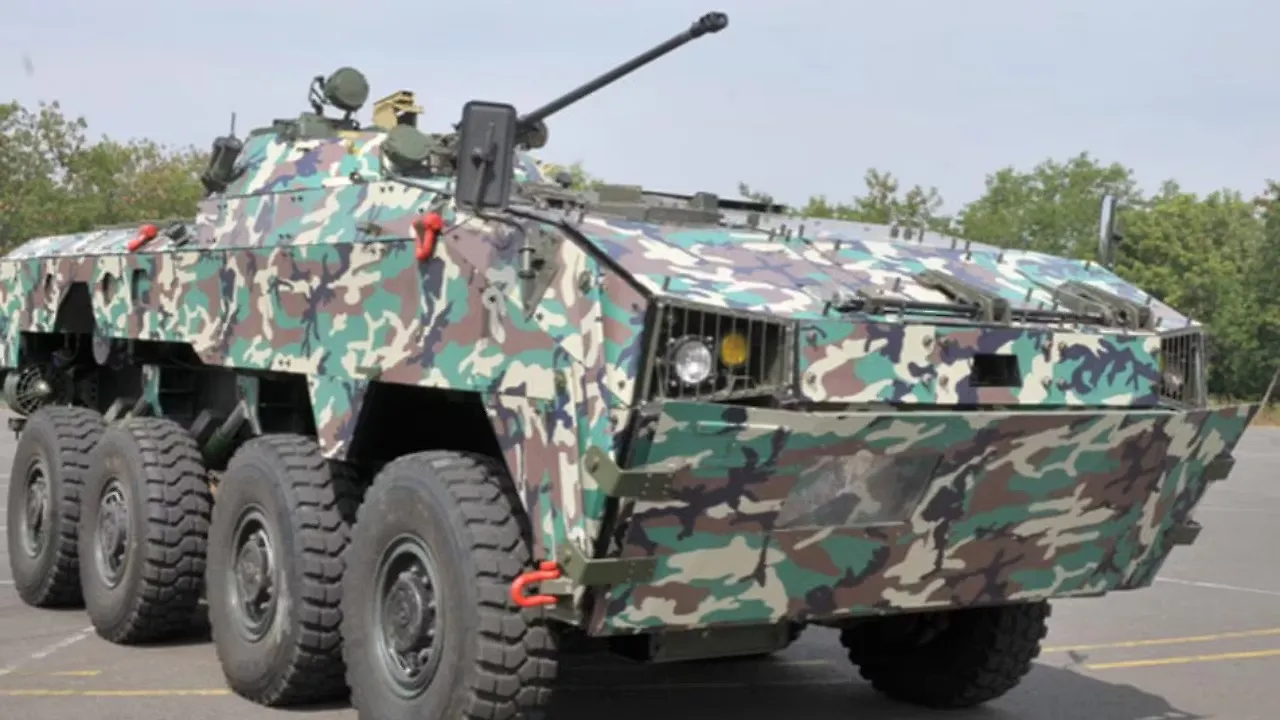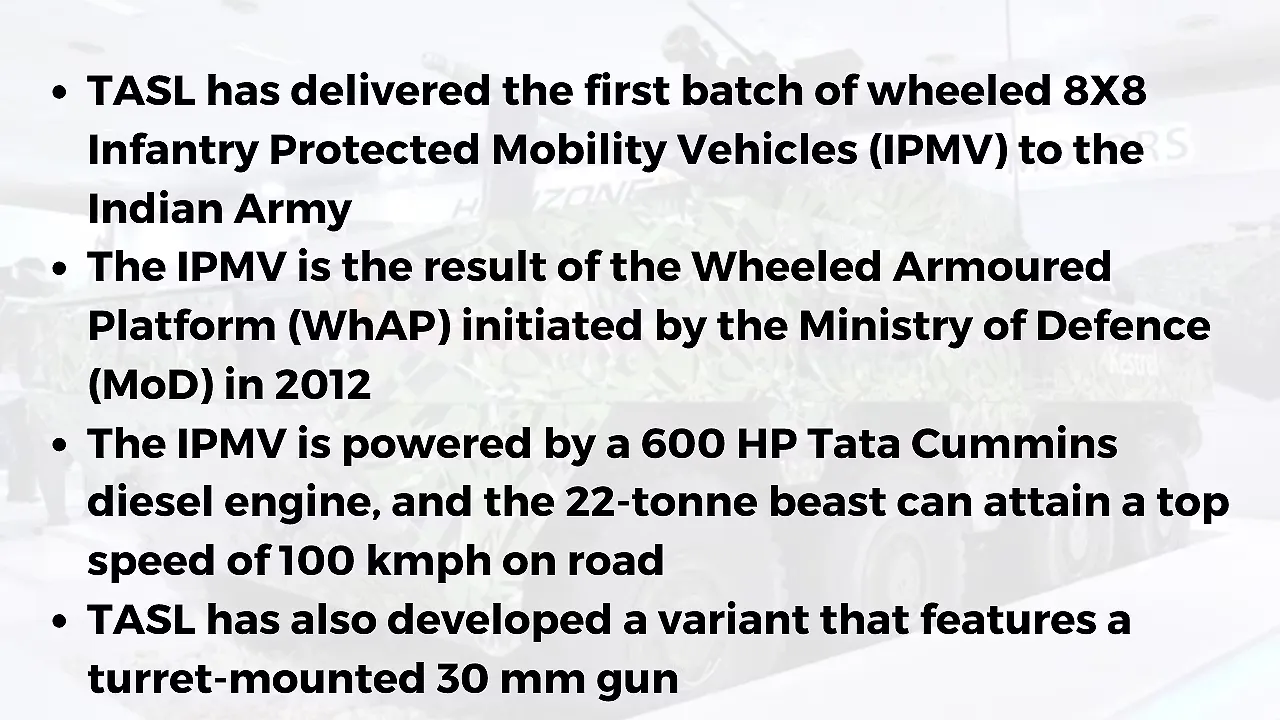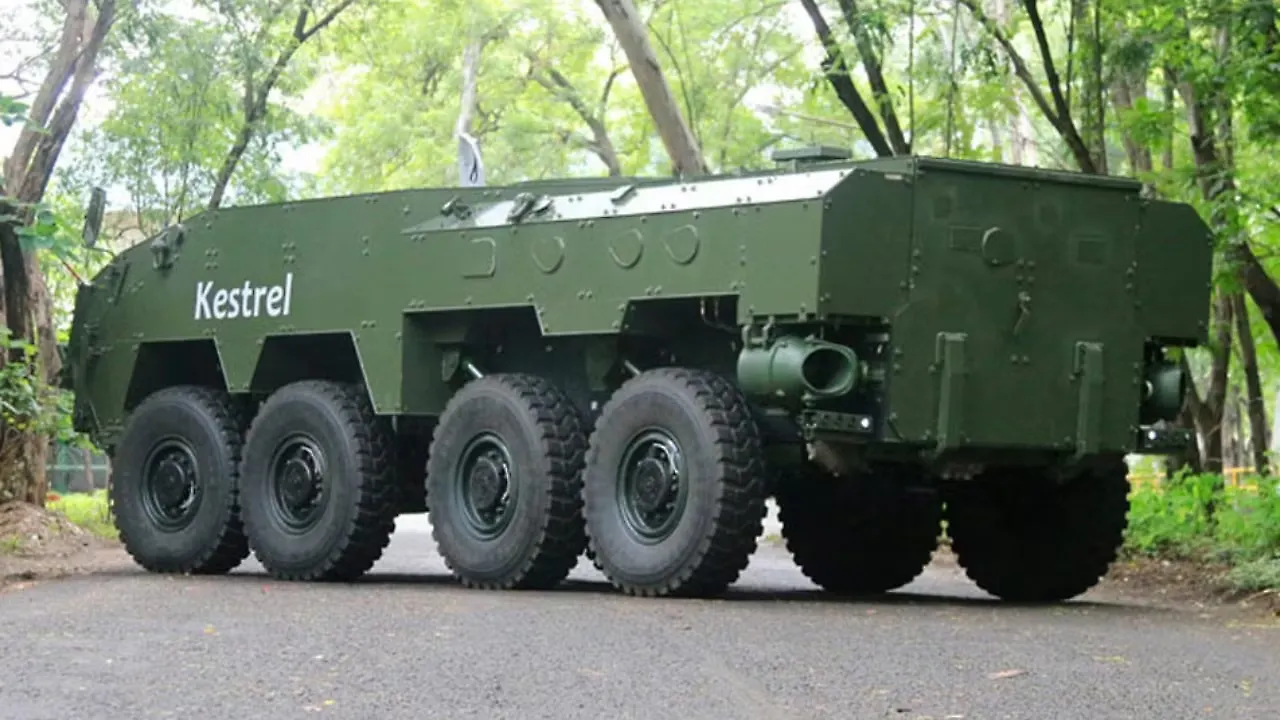
The delivery of the first batch of 8X8 Infantry Protected Mobility Vehicles (IPMV) by Tata Advanced Systems Limited (TASL) to the Indian Army is the first instance of an indigenously developed combat-ready 8X8 wheeled armoured vehicle entering service with the army.
The army took delivery of the impressive looking vehicles at its Bombay Engineering Group Centre in Pune, along with the delivery of 4X4 Quick Reaction Fighting Vehicles (QRFV) also from TASL, at the same event. According to Sukaran Singh, MD & CEO, TASL, the delivery of the IPMV’s marked the first commercial sale of a strategic platform that has been co-developed by DRDO and a private player.
Joint Development
The IPMV results from the Wheeled Armoured Platform (WhAP) programme, initiated by the Ministry of Defence (MoD) in 2012. The basis of the programme was the need to develop a wheeled Infantry Combat Vehicle (ICV) that could be used over hilly terrain.
The development of the 8X8 WhAP was initially undertaken by the Defence Research & Development Organisation (DRDO) to provide a replacement for the Army’s Russian origin BMP-II tracked armoured personnel carriers (APC), which were first inducted starting in the mid-eighties and are still being built under license in India. The DRDO had also taken up the project to develop a vehicle to meet the APC requirements for United Nations missions.
The WhAP was intended to be a common platform on which armoured vehicles for various roles would be developed, such as wheeled APC, 30 mm ICV, 105 mm light tank, command post vehicle, ambulance, special-purpose platform, 120 mm mortar carrier, Chemical, Biological, Radiological and Nuclear (CBRN) vehicle.

The defence business of Tata Motors Limited (now under TASL) was selected to partner with the Vehicles Research & Development Establishment (VRDE) to develop the armoured vehicle. As part of the WhAP joint design and development project with DRDO, TASL has gained an unmatched understanding of armoured fighting vehicle technology and grown its existing armoured land systems development capability well beyond that of other Indian private sector firms operating in the defence domain.
The wheeled ICV was named Kestrel during its development by Tata Motors. The first prototype was displayed at DefExpo 2014, and technical inputs were received from Supacat of the UK. The indigenous wheeled armoured platform was configured around two distinct entities in the overall design: the base hull and the modular mission payload; the latter was adopted to user-specific requirements.
Developmental trials of the WhAP were carried out in two phases. On-road and Off-road mobility trials began in October 2014 and were conducted at National Centre for Automotive Testing (NCAT) at VRDE and a vehicle track at the Army’s Mechanized Infantry Regimental Centre (MIRC). During initial trials, the prototype vehicle delivered a fuel efficiency of 1.3 kmpl, giving it a range of 478 km on a full tank of diesel. Amphibious trials commenced in August 2015. In January this year, TASL announced the completion of successful trials in Ladakh.
The decade long design effort has eventually matured into a modular and scalable design, which could cater for a future increase in gross vehicle weight from 22.5 tonne up to 26 tonne without any reduction in performance. The IPMV is powered by a Tata Cummins water-cooled turbocharged diesel engine generating 600 HP at 2,000 rpm and 2,400 Nm of max torque at 1,500-1,700 rpm. As a result, there is no performance deficit in desert and high-altitude areas, and the unique independent hydropneumatic suspension allowed the vehicle to attain a top speed of 100 kmph on land and ten kmph in amphibious mode.
Capability Delivered
APCs are complicated to design and develop due to the myriad challenges of mobility, performance, weight, protection, firepower, etc. The IPMV can carry up to 10 personnel and two crew members. Therefore, the troop compartment has been designed considering crew ergonomics and comprises a firing port and periscopes.

The vehicle combines an integrated blast and ballistic protection system and a V-shaped hull that deflects the explosive effect of mine blasts. The seats inside the vehicle feature a suspended design with mine blast attenuation to protect soldiers from such explosions. The hydraulically operated rear-door ramp enables easy embarking and disembarking of troops. The troops are also provided with two escape hatches above the crew compartment. The IPMV also features air conditioning and heating for improved crew comfort.
TASL has equipped the IPMV with an in-house designed and developed Remote Controlled Weapon Station (RCWS), which is likely to be fitted with a single 7.62 mm co-axial medium machine gun (MMG). The vehicle also features external add-on armour protection panels developed by the Defence Metallurgical Research Laboratory of DRDO. The vehicle also features a Nuclear, Biological and Chemical (NBC) protection system. TASL has also been contracted by the army to provide 24x7 support to maintain the vehicles at the deployment locations.
Another variant of this 8X8 APC is fitted with a new and state-of-the-art weapons turret with a 30 mm remotely operated cannon and an advanced fire control system. As per the requirement, it can also integrate anti-tank guided missiles (ATGMs). This version is also fitted with a laser range finder that can track targets up to 10km away, while a thermal imager sight helps detect, recognise, and identify targets, both during the day and night.
An optional Active Protection System (APS) is also available, which can destroy incoming rockets/projectiles with an explosive charge. A Laser Detection and Warning System protects the vehicle against laser-guided munitions and sighting systems by activating smoke grenades.